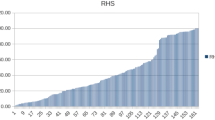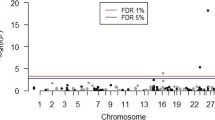Abstract
Neonatal diarrhea caused by enterotoxigenic Escherichia coli (ETEC) F4 is a common and serious disease, resulting in significant economical loss in the pig industry. The locus encoding ETEC F4 receptor has been mapped to pig chromosome (SSC) 13q41, and one of the most significantly linked markers is S0075. In this study, we selected three genes including SLC12A8, MYLK and KPNA1 from a chromosomal region flanking S0075 on SSC13 to develop pig specific sequence tagged sites (STS). Seven single nucleotide polymorphisms were identified in the three pig STS using DNA of four full-sib susceptible and resistant animals in a White Duroc × Erhualian intercross. All grandparents, parents and 755 offspring in the intercross were genotyped for three polymorphisms, including SLC12A8 g.159A>G, MYLK g.1673A>G and KPNA1 g.306A>G. Family-based transmission disequilibrium test (TDT) revealed that all polymorphisms and the corresponding haplotypes are significantly associated with ETEC F4ab/ac (especially F4ac) brush border adhesion phenotypes, indicating that these polymorphism are in linkage disequlibrium with causal mutation(s) of the gene encoding ETEC F4ab/ac receptor. Our results strengthen the evidence for the involvement of SSC13q41 in high acquiring risk of ETEC F4ab/ac infection, and provide novel polymorphic markers for fine mapping of the ETEC F4ab/ac receptor locus.
Similar content being viewed by others
References
Wilson R A, Francis D H. Fimbriae and enterotoxins associated with Escherichia coli isolated from pigs with colibacillosis. America Journal of Veterinary Research, 1986, 47: 213–217, 1:STN:280:BimC2MjgsVI%3D
Moon H W, Bunn T O. Vaccines for preventing enterotoxigenic Escherichia coli infections in form animals. Vaccine, 1993, 11: 213–220, 8094931, 10.1016/0264-410X(93)90020-X, 1:STN:280:ByyC2srht1c%3D
Henton M M, Engelbrecht M M. Escherichia coli serotypes in pigs in South Africa. J Vet Res, 1997, 64: 175–187, 1:STN:280:DyaK1c7ivVahtw%3D%3D
Choi C, Chae C. Genotypic prevalence of F4 variants (ab, ac and ad) in Escherichia coli isolated from diarrheic piglets in Korea. Vet Microbiol, 1999, 67: 307–310, 10466506, 10.1016/S0378-1135(99)00046-2, 1:CAS:528:DyaK1MXks1Ggsb8%3D
Osek J. Prevalence of virulence factors of Escherichia coli strains isolated from diarrheic and healthy piglets after weaning. Vet Microbiol, 1999, 68: 209–217, 10510040, 10.1016/S0378-1135(99)00109-1, 1:STN:280:DyaK1MvjslOguw%3D%3D
Bijlsma I G, de Nijs A, van der M C, et al. Different pig phenotypes affect adherence of Escherichia coli to jejunal brush borders by K88ab, K88ac and K88ad antigen. Infect Immunol, 1982, 37: 891–894, 1:STN:280:BiyD38bntlU%3D
Cox E, Houvenaghel A. Comparison of the in vitro adhesion of K88, K99, F41 and P987 positive Escherichia coli to intestinal villi of 4-to 5-week-old pigs. Vet Microbiol, 1993, 34: 7–18, 8447080, 10.1016/0378-1135(93)90003-P, 1:STN:280:ByyC1M%2FkvVw%3D
Chandler D S, Mynott T L, Luke R K, et al. The distribution and stability of Escherichia coli K88 receptor in the gastrointestinal tract of the pig. Vet Microbiol, 1994, 38: 203–215, 7912466, 10.1016/0378-1135(94)90002-7, 1:CAS:528:DyaK2cXivFGmtLc%3D
Moon H W, Hoffman L J, Cornick N A, et al. Prevalences of some virulence genes among Escherichia coli isolates from swine presented to a diagnostic laboratory in Iowa. J Vet Diagn Invest, 1999, 11: 557–560, 12968745, 1:STN:280:DC%2BD3svivVSisA%3D%3D
Gibbons R A, Sellwood R, Burrows M, et al. Inheritance of resistance to neonatal E. coli diarrhoea in the pig: Examination of the genetic system. Theor Appl Genet, 1977, 51: 65–70, 10.1007/BF00299479
Sellwood R. Escherichia coli diarrhoea in pigs with and without the K88 receptor. Vet Rec, 1979, 105: 228–230, 399711, 1:STN:280:Bi6D2Mjkt1M%3D
Ørskov I, Ørskov F, Sojka W J, et al. K Antigens K88ab(L) and K88ac(L) in E. coli: A new O antigen: O147 and a new K antigen: K89(B). Acta Pathol Microbiol Scand, 1964, 62: 439–447, 14227889
Edfors-Lilja I, Gustafsson U, Duval-Iflah Y, et al. The porcine intestinal receptor for Escherichia coli K88ab, K88ac: Regional localization on chromosome 13 and influence of IgG response to the K88 antigen. Anim Genet, 1995, 26: 237–242, 7661395, 1:CAS:528:DyaK2MXnslSkur0%3D
Python P, Jörg H, Neuenschwander S, et al. Fine-mapping of the intestinal receptor locus for enterotoxigenic Escherichia coli F4ac on porcine chromosome 13. Anim Genet, 2002, 33: 441–447, 12464019, 10.1046/j.1365-2052.2002.00915.x, 1:CAS:528:DC%2BD3sXjslyhu7Y%3D
Jørgensen C B, Cirera S, Anderson S I, et al. Linkage and comparative mapping of the locus controlling susceptibility towards E. coli F4ab/ac diarrhoea in pigs. Cytogenet Genome Res, 2003, 102: 157–162, 14970696, 10.1159/000075742
Baker D R, Billey L O, Francis D H. Distribution of K88 Escherichia coli-adhesive and nonadhesive phenotypes among pigs of four breeds. Vet Microbiol, 1997, 54: 123–132, 9057256, 10.1016/S0378-1135(96)01277-1, 1:STN:280:ByiB3M%2FgvVU%3D
Zapata C, Carollo C, Rodriguez S. Sampling variance and distribution of the D′ measure of overall gametic disequlibrium between multiallelic loci. Ann Hum Genet, 2001, 65: 395–406, 11592929, 10.1046/j.1469-1809.2001.6540395.x, 1:STN:280:DC%2BD3MrlvFKqtQ%3D%3D
Zhao J H 2LD, GENECOUNTING and HAP: Computer programs for linkage disequilibrium analysis. Bioinformatics, 2004, 20: 1325–1326, 14871868, 10.1093/bioinformatics/bth071, 1:CAS:528:DC%2BD2cXkt1Srtb0%3D
Clayton D. A generalization of the transmission/disequilibrium test for uncertain-haplotype transmission. Am J Hum Genet, 1999, 65: 1170–1177, 10486336, 10.1086/302577, 1:STN:280:DC%2BD3cvnsFeksQ%3D%3D
Peng Q L, Ren J, Yan X M, et al. The g.243A>G mutation in intron 17 of MUC4 is significantly associated with susceptibility/resistance to ETEC F4ab/ac infection in pigs. Anim Genet, 2007, 38: 397–400, 17559554, 10.1111/j.1365-2052.2007.01608.x, 1:CAS:528:DC%2BD2sXhtVeiurjM
Berghmans S, Segers K, Shay T, et al. Breakpoint mapping positions the callipyge gene within a 450-kilobase chromosome segment containing the DLK1 and GTL2 genes. Mammalian Genome, 2001, 12: 183–185, 11210193, 10.1007/s003350010246, 1:CAS:528:DC%2BD3MXhsFSgt7k%3D
Python P, Jörg H, Neuenschwander S, et al. Inheritance of the F4ab, F4ac and F4ad E. coli receptors in swine and examination of four candidate genes for F4acR. J Anim Breed Genet, 2005, 122: 5–14, 16130451, 10.1111/j.1439-0388.2005.00490.x, 1:CAS:528:DC%2BD2MXjsFyqurk%3D
Wang Y Z, Ren J, Lan L T, et al. Characterization of polymorphisms of transferrin receptor and their association with susceptibility to ETEC F4ab/ac in pigs. J Anim Breed Genet, 2007, 124: 225–229, 17651325, 10.1111/j.1439-0388.2007.00664.x, 1:CAS:528:DC%2BD2sXhtVent7%2FO
Author information
Authors and Affiliations
Corresponding author
Additional information
Supported by National High Technology Research and Development Program of China (“863” Program) (Grant No. 2006AA10Z194), and Jiangxi Provincial Key Research Project
Rights and permissions
About this article
Cite this article
Huang, X., Ren, J., Yan, X. et al. Polymorphisms of three gene-derived STS on pig chromosome 13q41 are associated with susceptibility to enterotoxigenic Escherichia coli F4ab/ac in pigs. SCI CHINA SER C 51, 614–619 (2008). https://doi.org/10.1007/s11427-008-0078-9
Received:
Accepted:
Published:
Issue Date:
DOI: https://doi.org/10.1007/s11427-008-0078-9




